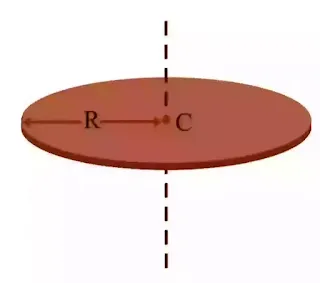In this article, you will learn a complete overview of the perpendicular axis theorem such as its definition, formula, derivation, application, calculation, etc.
The moment of inertia of plane lamina about an axis perpendicular to its plane is equal to the sum of its moment of inertia about two mutually perpendicular axes concurrent with the perpendicular axis & lying in the plane of the laminar body is the perpendicular axis theorem.
This perpendicular axis theorem is only good for plane laminar objects.
We have also discussed the parallel axis theorem in our previous article here we will learn only about the perpendicular axis theorem.
So, without wasting time let's get started.
Definition of Perpendicular Axis Theorem
The theorem states that the moment of inertia of a plane laminar body about an axis perpendicular to its plane is equal to the sum of moments of inertia about two perpendicular axes lying in the plane of the body such that all three axes are mutually perpendicular and have a common point.
This theorem is also called the polar axis theorem.
This theorem is also known by plane figure theorem because it is limited to planar lamina such as a 2d plane.
Mathematically,
Iz = Iₓ + Iᵧ
Where,
Iz = Moment of Inertia about the Z axis
Iₓ = Moment of Inertia about the X axis
Iᵧ = Moment of Inertia about the Y axis
Perpendicular axis theorem proof
To prove this theorem, let us consider a plane laminar object of negligible thickness on which lies the origin O . The X and Y axes lie on the plane, and Z axis is perpendicular to it as shown in the figure.
The lamina is considered to be made up of a large number of particles of mass m.Let us choose one such particle dm at a point P which has coordinates ( x, y ) at a distance r from O.
Let Iₓ, Iᵧ, and Iz be moments of Inertia about the X, Y, and Z axis respectively.
As we know,
The basic formula of the moment of inertia is ∑mr².
But here we will take integration instead of summation because we have taken a small segment.
So, the moment of inertia of the x-axis,
Iₓ = ∫y².dm
Similarly,
Iᵧ = ∫x².dm
Iz = ∫r.²dm
Now, △OLP
r² = x² + y²
after taking both side integration and multiplying with dm.
∫r.²dm = ∫x².dm + ∫y².dm
Iz = Iₓ + Iᵧ
Application of Perpendicular Axis Theorem
The common application of the perpendicular axis theorem is to find the moment of inertia and area moment of inertia of a given rigid body about any axis.
Through the perpendicular axis theorem, the moment of inertia about a third axis can be easily calculated.
Below we will use the perpendicular axis theorem to find the moment of inertia of some body.
Ring
Using a perpendicular axis theorem find the moment of inertia about the diameter of the ring.
As we know,Iz = MR²
So, As we know,
Iz = Iₓ + Iᵧ
Iₓ = Iᵧ = I
MR² = I + I
I = MR²/2
Disc
Using the perpendicular axis theorem find a moment of inertia about the diameter of the disc.
As we know,
Iz = MR²/2
So,
Iz = Iₓ + Iᵧ
Iₓ = Iᵧ = I
Iz = I + I
I = MR²/4
Rectangular Section
Using the perpendicular axis theorem find the moment of inertia of the rectangular section about the z-axis.
As we know,Iₓ = Mb²/12
Iᵧ = Ml²/12
So,
Iz = Iₓ + Iᵧ
Iz = Mb²/12 + Ml²/12
Iz = M/12(b² + l²)
Calculation
Question
A thin ring of mass 0.25 kg and radius 0.5m. Calculate the moment of inertia about an Axis passing through a point in diameter.
Solution
Given Data
M = 0.25 kg
R = 0.5 m
As we know the moment of inertia of the ring is about diameter.
I = MR²/2
So,
I = (0.25 × 0.5²)/2
I = 0.03125 kg-m²
So here you have to know all aspects related to the perpendicular axis theorem. If you have any doubts then you are free to ask me by mail or on the contact us page.
Thank You.







0 Comments